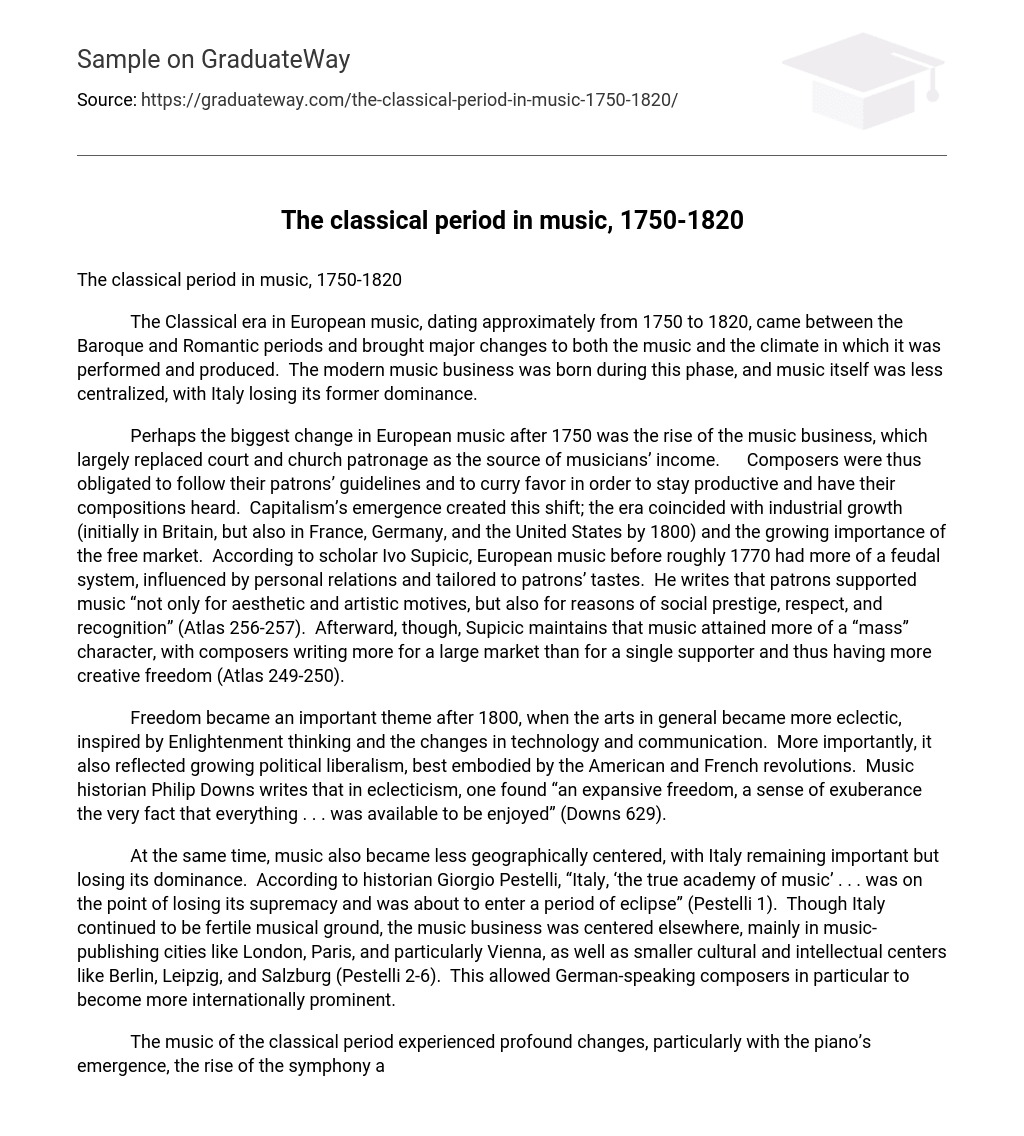The Classical era in European music, dating approximately from 1750 to 1820, came between the Baroque and Romantic periods and brought major changes to both the music and the climate in which it was performed and produced. The modern music business was born during this phase, and music itself was less centralized, with Italy losing its former dominance.
Perhaps the biggest change in European music after 1750 was the rise of the music business, which largely replaced court and church patronage as the source of musicians’ income. Composers were thus obligated to follow their patrons’ guidelines and to curry favor in order to stay productive and have their compositions heard. Capitalism’s emergence created this shift; the era coincided with industrial growth (initially in Britain, but also in France, Germany, and the United States by 1800) and the growing importance of the free market. According to scholar Ivo Supicic, European music before roughly 1770 had more of a feudal system, influenced by personal relations and tailored to patrons’ tastes. He writes that patrons supported music “not only for aesthetic and artistic motives, but also for reasons of social prestige, respect, and recognition” (Atlas 256-257). Afterward, though, Supicic maintains that music attained more of a “mass” character, with composers writing more for a large market than for a single supporter and thus having more creative freedom (Atlas 249-250).
Freedom became an important theme after 1800, when the arts in general became more eclectic, inspired by Enlightenment thinking and the changes in technology and communication. More importantly, it also reflected growing political liberalism, best embodied by the American and French revolutions. Music historian Philip Downs writes that in eclecticism, one found “an expansive freedom, a sense of exuberance the very fact that everything . . . was available to be enjoyed” (Downs 629).
At the same time, music also became less geographically centered, with Italy remaining important but losing its dominance. According to historian Giorgio Pestelli, “Italy, ‘the true academy of music’ . . . was on the point of losing its supremacy and was about to enter a period of eclipse” (Pestelli 1). Though Italy continued to be fertile musical ground, the music business was centered elsewhere, mainly in music-publishing cities like London, Paris, and particularly Vienna, as well as smaller cultural and intellectual centers like Berlin, Leipzig, and Salzburg (Pestelli 2-6). This allowed German-speaking composers in particular to become more internationally prominent.
The music of the classical period experienced profound changes, particularly with the piano’s emergence, the rise of the symphony and concerto, and comic opera’s popularity. The piano, invented in 1711 by Bartolomeo Cristofori, challenged the dominance of both the violin and harpsichord, toppling the latter from widespread favor and proving itself most useful in concertos (in which the orchestra backed the solo piano) and especially sonatas (Pestelli 12-13).
In the second case, orchestral music moved from the Baroque era’s polyphony to a larger, more unified homophonic sound, especially as the symphony expanded and placed more emphasis on theme development (Pestelli 13). Also, composers like Joseph Haydn and Ludwig van Beethoven brought the sturm und drang (“storm and stress”) character of contemporary German literature into the symphony, giving the form “a terrible seriousness that made the tone of the Protestant north felt against the southern Catholic tradition” (Pestelli 103).
Comic opera gained popularity from roughly 1760 onward, slowly superceding the more serious, hero-centered opera seria, though by 1800 the comic and serious forms began slowly merging; Gluck’s Orfeo ed Euridice is an example (Pestelli 41-42). Opera seria was inspired more by antiquity and mythology, due partly to the rise of modern archeology at about this time, which inspired popular interest in an imagined epic past (and helped influence the Romantic era as well). However, other cultures came into vogue during the Classic period, mainly Turkish, Arab, and especially Chinese (Pestelli 52-54). Another change to opera was the use of dialogue; where Italian opera was wholly sang (and was most popular in London), French, German, and English comic operas alternated singing with spoken parts (Pestelli 93), making them slightly similar to the light opera and musicals that emerged later in the nineteenth century.
Though the era included great composers like Haydn and Beethoven, Wolfgang Mozart was probably the period’s dominant figure. He mastered several genres, including both forms of opera, symphonies, concertos, and sacred music. He represented the era’s trends by working independent and not spending his entire career dependent on court patronage, and he mastered each of the era’s forms (symphonies, concertos, operas, and sacred music). Beethoven followed in his footsteps as a mostly independent musician , taking his music more in the direction Romanticism would later follow, embracing sturm und drang, love of freedom, an idealistic view of humanity, and creating music “totally oriented toward a state of happiness situated at infinity” (Pestelli 225).
In general, the Classical period in European music reflected the social and economic changes of the 1750-1820 era. As capitalism rose, the music business took form, meaning that musicians were less likely to seek court or church patronage and more likely to perform or compose for the emerging market. In addition, music’s geography changed, making Italy just one of many hotbeds of musical activity. The music itself was changed by the piano’s emergence as an important instrument for concertos and sonatas alike, by the emergence of comic opera, and changes in musical subject matter and content. The period was, overall, a sort of transition to modernity.
REFERENCES
Atlas, Allan W. ed. Music in the Classic Period. New York: Pendragon Press, 1985.
Downs, Philip G. Classical Music. New York: W.W. Norton, 1992.
Pestelli, Giorgio. The Age of Mozart and Beethoven. Cambridge: Cambridge University Press, 1984.





